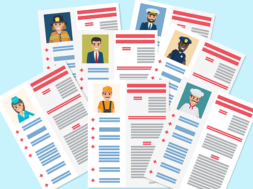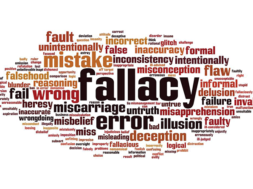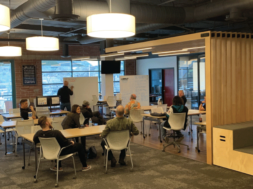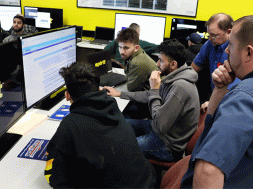
Show Them the Way: Career Services Experts Share Best Job Search Practices for Students
By Jamie Gadette, Content Director, JobDash
Rebecca Edwards was a single mom and freelance writer when she fell into a job with the Utah College of Massage Therapy, initially hired to take over the school’s “sad little newsletter” before seguing into a full-time role in career services. She ended up creating one of the most successful placement departments in the business with employers from around the world flying in to meet with the massage therapy graduates. “I got addicted to the satisfaction of seeing someone accomplish their goals and make the life they had always hoped for,” Edwards says. “I have also had the chance to expand into the campus leadership, compliance, curriculum development, and accreditation side of things, which has become an equal passion – but the graduate/student interaction makes sure I always remember the ‘why’ of what we do.”
Edwards’ enthusiasm for her craft is not uncommon among career services professionals who tend to eat, sleep and breathe career development. As experts in helping others achieve their employment goals, these individuals are an increasingly valued part of a sector currently under pressure to prove the continued value of a college degree to policymakers, stakeholders and prospective students. In a recent poll conducted by JobDash, 100 representatives of career services departments across the country weighed in on best job search practices, offering well-informed and occasionally divergent opinions on everything from job applications to negotiating the job offer.
The only piece of advice respondents universally agreed upon? Never, ever complain about former employers in a job interview.
Other questions yielded a broader range of opinions. Edwards agreed to share her take on the survey’s biggest results.
Apply yourself
While 98 percent of JobDash survey participants believe it is critical for students to research each position and company they pursue, respondents are split on the number of applications it takes before a student actually gets hired. 49 percent agree that 50 applications is a reasonable amount to submit if a student wants to get a job in three months. 51 percent say that number is way too high, way too low, or completely arbitrary:
“It depends on the industry, level of job, and experience the candidate has in the field. They should apply to as many positions that they see at organizations which they would actually be interested in. Some may get interview calls after only 5 applications, some not until 25 applications.”
“It takes more than 50 and at least 2-3 hrs a day applying.”
“There is no magic number. Although applying to just one or two positions, certainly will not maximize your opportunity to get hired. You want to apply to many positions, but also apply to positions that you are qualified for and more importantly positions you are interested in obtaining.”
Edwards, who in her current role as career services director at Eagle Gate College works with individuals pursuing entry-level positions with room for growth and advancement, does not see a one-approach-fits-all solution to application success rates. Approximately 50 percent of her students secure employment through program-related externships, but even those candidates are subject to a variety of external and internal forces. “Depending on other factors including the student’s willingness to apply for everything (one of my mottoes) it can take anywhere from three to 30 applications” before an offer comes through. Edwards is much more clear on her stance regarding one-click applications which, although useful for assisting students with Asperger’s, for example, do not do the job seeker any favors. “It is always the one-on-one interaction that scores the job offer and sometimes the perfect candidate does not show up that way on paper,” she says. “I, myself, do not have a degree, but I am one of the best at what I do. If I had to apply to a one-click application that automatically disqualifies anyone without a degree, then a company could miss out on 20 years of successful experience and knowledge without a real person ever getting the chance to see my resume.”
95 percent of JobDash survey respondents agree with Edwards, dismissing one-click job applications as a misleading time saver that leads nowhere fast:
“Expecting things to be easy will throw a student for a looper when they come across an employer who expects them to make an effort to apply. They are not ordering a pair of shoes, it should be more thoughtful than that. With that said, employers should consider how onerous they are making the application process.”
“The speed is not as important as the accuracy of the information that the students provide.”
Resume rules
Prior to entering the field of career services, Edwards did not think much about the process it takes to get a job. She was always at the right place, at the right time, with the best skills for the position at hand. One of the biggest misconceptions she had about job search concerned resumes, specifically the importance of customizing a resume for each position pursued. Over time she has tailored her own resume to suit a variety of employment opportunities and encourages students to follow suit. “One medical assisting student I worked with applied for eight different positions at University of Utah hospital, but really wanted to work with dialysis patients,” Edwards says. “When she got called for an interview the HR representative she met with noted that the student had slightly changed her application and resume for each position and was really impressed. Ultimately, she was able to pick the job she wanted and it was the one in dialysis.”
94 percent of JobDash survey respondents support the creation of customized resumes over attaching the same resume to every job application,
noting that while it is good to have a master resume to serve as a universal template, resumes should be altered to fit the job description requirements and tone:
“Write a targeted resume with appropriate keywords for each job.”
“Applications vary, so it is important to have a resume to fit the needs of the employer.”
“You may have many different resumes. It is important to make sure your documents accurately reflect your strengths, skills and abilities based on what they are seeking.”
“It is not fool-proof,” Edwards says, “but taking the time to tailor the resume to the job can make a difference.”
Another tip for winning resumes? Skip the glamour shot and the list of references. 85 percent of JobDash survey respondents say that unless a student is applying for a job that directly involves their physical appearance (modeling, acting, etc), there is absolutely no reason to include a photo on a resume. In fact, it can be a major turn-off for employers. This might seem like an obvious red flag, but many have a harder time understanding why references do not belong on resumes. Only 15 percent of the survey respondents still encourage students to follow that practice.
85 percent say it is better to provide references upon request, which usually occurs after an interview:
“Have a typed list of references to submit. Wait for employer to ask. That space on the resume is needed for achievements and skills.”
“It is only necessary to provide references if the company is planning on extending an offer. Think of your references as very precious resources. Also, you do not want the reference to get ‘watered down.’ Often, you are not as wonderful the 15th time they have been contacted.”
“A reference page is its own entity and should only be provided when asked.”
First impressions
One of the most important things Edwards focuses on preparing students for is the job interview, which can make or break their chances of getting a job regardless of skill level or right they are for the position. First and foremost, she recommends that students invest serious thought and energy into researching each position and company before meeting with employers. “Understanding their mission and core values is key,” she says. “If you can show up and speak to those things it will seem like you are already on the same page – already ‘one of us.’ Finding someone who ‘gets it’ is often a top priority.” Timing is also a chief concern. Do not be late, but also, do not wear out your welcome by arriving too early. Edwards says ideally students should show up to a job interview 10 minutes before it is scheduled to begin. 87 percent of JobDash survey respondents say that 45 minutes is way too early to arrive for an interview, recommending a variety of less extreme windows to get situated for the big opportunity.
Do not go into the office until 10 minutes before. Anything more than that is a nuisance to the employer.” “We recommend 15 minutes.”
“45 minutes is too early, is shows the employer you are desperate.”
“Do not ‘check-in’ 45 minutes early. But, I do suggest that students get to the general location 30 to 45 minutes early to ensure that they will not be late. They can either grab a bite locally or sit in their car. Then they should check in 8-10 minutes prior to their interview.”
“If you show up too early you are risking inconveniencing the interviewer and causing them to be flustered, pressured or otherwise made uncomfortable – not the state of mind you want them in entering into an interview,” Edwards says.
“And no matter how early you show up – do not play on your phone. I have had people lose their shot because the doctor was paying attention and ruled out everyone who was playing on their phone, even before the interview. Do not bring it in if you can help it.”
And, as previously mentioned, the best way to send an interview off the rails is to complain about former employers. If asked about a previous job, students should focus on any positive aspects they can think of (compiling a list ahead of time is best) and address negative aspects as welcome challenges from which they learned and grew.
But what if the interview went well? What next? “I still believe mailing a handwritten thank you note the same day is classy and makes a huge impact because so few people do it,” Edwards says. “I know people who have been passed over who got called back a month later when the other candidate did not work out – and that call came because of the thank you note the hiring manager still had in their drawer.” When asked whether 48 hours is a reasonable time frame to wait before following up on a job interview, 82 percent of JobDash survey respondents said two days is spot on. The other 18 percent suggest different approaches to nailing this aspect of job search:
“They should ask what the next steps are in the process, wait the amount of time the employer states, and if they do not hear after that amount of time then they can call to check in.”
“Only with a hard copy, handwritten thank you note. They should be asking at the end of their interview what the next steps are and not bugging them until that time frame is met.”
“12-24 hours for a thank-you note; one week for additional follow up.”
“Only if follow up is a thank you for taking the time to meet with them, not to ask for an update.”
“Thank you, yes. Follow up, no. Wait until a reasonable amount of time, based on what the interviewer stated as a timeline for the next contact.”
“Thank you letter immediately; call at about 4 to 5 days to follow up.”
Red light. Green light.
Whether it takes one, two or several interviews for employers to make a hire, there are two options facing students: rejection and acceptance. How they react to either result can greatly influence their professional satisfaction moving forward.
When students are passed over for a position it could be a smart move to ask the employer how they might improve for future opportunities.
For example, the employer might suggest they work on their interview skills or it could be a matter of acquiring more skills. They might even learn that another candidate simply seemed like a better cultural fit and the decision had nothing to do with their abilities or potential in the field. Edwards encourages students to adjust their approach on a case by case setting. If the employer seems receptive, ask away. “It might also be worthwhile to talk to their career services advisor and see if they can call and ask,” she says. “It is important to understand what is not working so they can improve their odds of an offer next time.”
90 percent of JobDash survey respondents agree with Edwards however the 10 percent who advise against asking employers for feedback think it is rather pointless:
“You are rarely going to hear the truth.”
“You can ask this information. You will not always get an answer.”
“Try visiting Career Services for a mock interview for this kind of feedback.”
When students reach the end of their job search journey and receive an offer, many career services advisors suggest that they make the most of the opportunity by negotiating the best deal possible. 86 percent of survey respondents say go for it! Still, they also advise students to exercise caution when engaging in this tricky dance with employers.
“Negotiations can be a delicate issue. A candidate could not get the job over another if one negotiates and the other does not. However, negotiate too aggressively and you could negotiate yourself out of a job. I wish I would have negotiated for my current position.”
“If you have conducted your research regarding salaries for this particular field and location, and you have determined that the average is higher and you have more experience that they are seeking, you have some room for discussion. This does not mean that the employer will have more money to pay.”
“Give the company an opportunity to show how much they want you. But do not get cocky. They are still taking a chance on you.”
Edwards says job offer negotiation comes down to expectations and needs. New graduates really have nothing to lose by accepting an offer straight away, as long as it pays a reasonable wage, offers a chance to acquire career-building skills and could open doors to future job opportunities. “To know if a wage is respectable that takes research and identification of the student’s specific needs and situation,” she says. “Saying no when you are just sitting on the couch because you think you deserve an unrealistic wage is self-sabotage and that grad needs to be de-programmed, albeit kindly and gently.”

Jamie Gadette is an experienced writer, editor and Content Director at JobDash, a company delivering innovative EdTech solutions to colleges and universities across the country. JobDash is a two-part solution that supports career services advisors by providing powerful insights into student job search activity, making it easier to track, predict, verify and report graduate placement rates for improved career outcomes. The platform also educates, encourages and empowers students to achieve employment with customized tools to chart their progress and increase active engagement.
JobDash is a technology company delivering a two-part cloud-based platform that educates, empowers and engages college students in effective job search while giving career services advisors and senior leadership tools to track, predict, improve and report student job placement rates. JobDash delivers real-time data-driven solutions for one of career education’s biggest challenges: bridging the gap between skills training and secure employment. To see JobDash in action, visit http://jobdash.com/request-demo/
Contact Information: Jamie Gadette // Content Director // JobDash // Phone: 888-995-9445 // jamie@jobdash.com
Summary: JobDash polled 100 career services professionals working in higher education to gather their expert opinions on best job search practices. Rebecca Edwards of Eagle Gate College joins the conversation by sharing her take on the informative results.










